Choosing Your Battles, Part 1
For this week, and the next two, I'm going to be examining all 36 battles and talking through how they were designed. For each one, I'll talk about the plane, walk through why we chose its color(s), what effect we chose to put on the "enters the battlefield" (ETB) effect on the front face, and the card we chose as the prize on the back face for winning the battle. I talk about the cards in collector number order, so first colorless, then monocolor, then multicolor.
Invasion of Ravnica
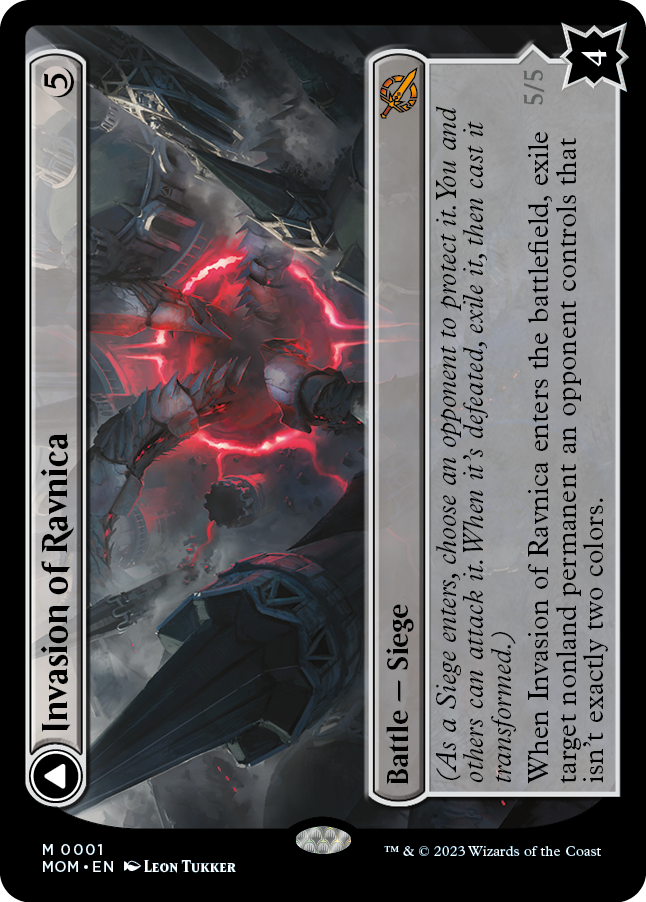
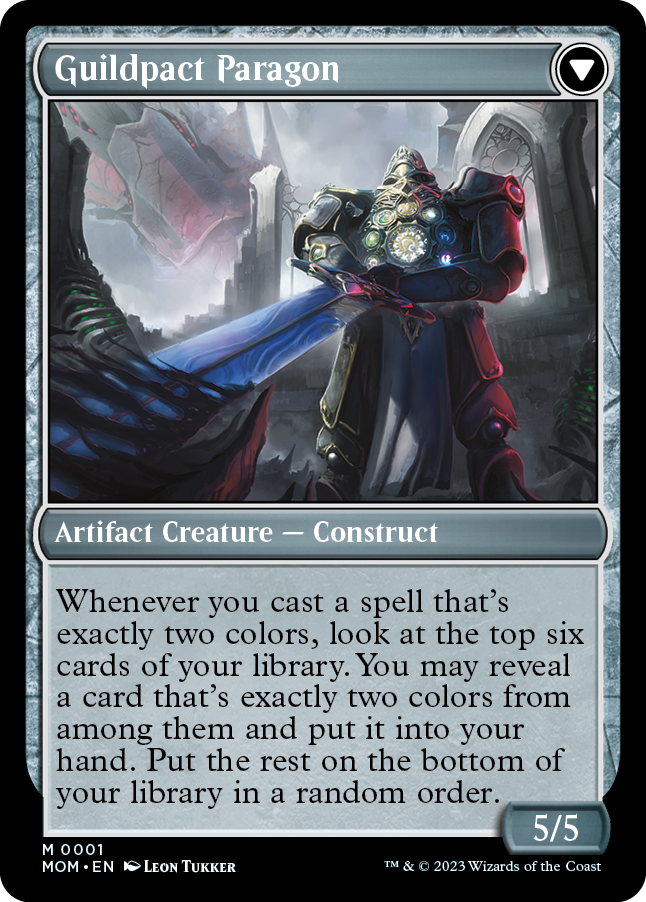
Invasion of Ravnica
Battle — Siege
(As a Siege enters, choose an opponent to protect it. You and others can attack it. When it's defeated, exile it, then cast it transformed.)
When Invasion of Ravnica enters the battlefield, exile target nonland permanent an opponent controls that isn't exactly two colors.
Sets that primarily take place there: Ravnica, Guildpact, Dissension, Return to Ravnica, Gatecrash, Dragon's Maze, Guilds of Ravnica, Ravnica Allegiance, and War of the Spark
Planeswalker natives (with planeswalker cards): Domri, Ral, and Vraska
I hope by now you all know the plane of Ravnica. It first appeared in the original Ravnica block, and we've revisited it twice for a total of nine sets. Only Dominaria has been the setting for more expansions. Ravnica is one of our most popular planes, known best for its guilds and two-color play.
Invasion of Ravnica is the only colorless battle. It felt odd to make Ravnica a single color because it's so iconic for being a two-color plane, but if we chose any one of the two-color pairs, it would feel like we were prioritizing one guild over another. The answer: make a five-color battle or a colorless one. We decided to make Alara the five-color battle (more on that when I get to it), so the Ravnica one ended up being colorless. Because a colorless card must follow certain restrictions as it relates to the color pie, we also chose to make the back face colorless. An artifact creature seemed the most flavorful option for a colorless creature on Ravnica.
Because the two-color guilds are so core to the identity of Ravnica, we chose to have both the "enters the battlefield" effect and the reward reference two-color cards. The ETB effect only works on permanents that aren't two colors, while the effect on the artifact creature on the back face rewards you for playing two-color cards.
Invasion of Belenon
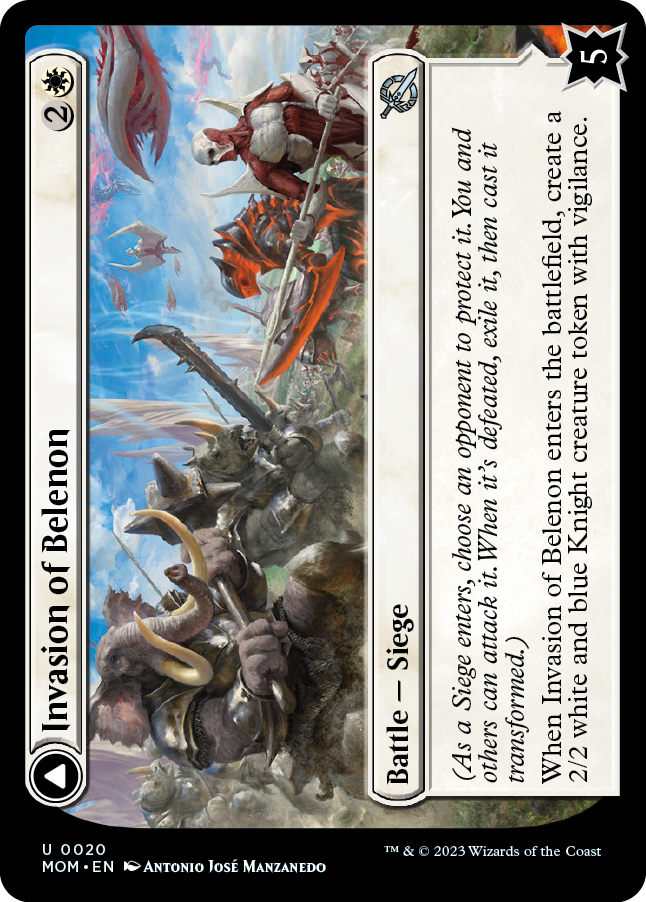
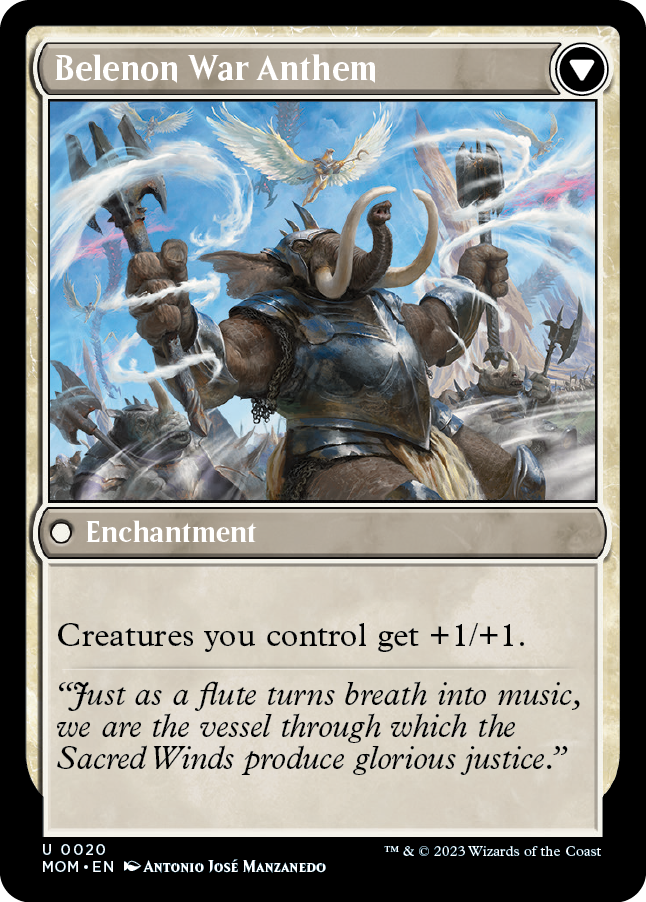
Invasion of Belenon
Battle — Siege
(As a Siege enters, choose an opponent to protect it. You and others can attack it. When it's defeated, exile it, then cast it transformed.)
When Invasion of Belenon enters the battlefield, create a 2/2 white and blue Knight creature token with vigilance.
Sets that primarily take place there: None
Planeswalker natives (with planeswalker cards): None
The only references to Belenon exist on two plane cards from Planechase (2012 Edition) (Edge of Malacol and Windriddle Palaces).
When designing cards for planes like Belenon that have so few references, we had to extrapolate from what was public knowledge. In this case, the two Planechase (2012 Edition) cards. We knew what some of their buildings looked like and saw a single wild creature, but other than that, it was wide open. For cards like this, we could lean into mechanical executions that we liked, as we were less beholden to matching flavor.
The white-blue archetype has a "Knights matter" theme, so this card was designed to play into that archetype. The ETB creates a white and blue Knight with vigilance (the Knight creature token that shows up in the set), and the back is an enchantment that buffs your team. Because this card is an uncommon, we wanted to keep it simple. White made the most sense for this battle because of the abilities we chose.
Then, we were able to build the flavor based on a combination of matching the mechanical needs of the card while staying true to the vibe of the two cards the plane appeared on before. We chose to make Belenon an animal humanoid plane where all the creatures are some kind of "animal person," except for the plane's humans. The three we show in the art are ones Magic has done before: Loxodon (elephants), Rhox (rhinos), and Aven (birds). We then made sure both faces were located at one of the places we'd previously seen (the Windriddle Palaces). Because we wanted the Knights vibe, it steered us toward making the conflict pictured on the card a bit more orderly with a clear group of trained soldiers with weapons.
Invasion of Dominaria

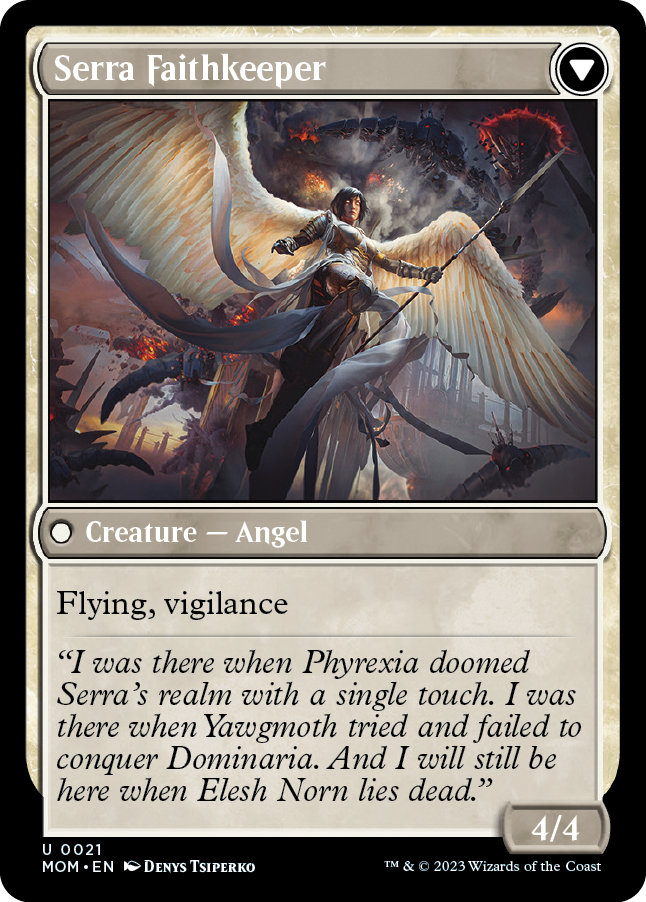
Invasion of Dominaria
Battle — Siege
(As a Siege enters, choose an opponent to protect it. You and others can attack it. When it's defeated, exile it, then cast it transformed.)
When Invasion of Dominaria enters the battlefield, you gain 4 life and draw a card.
Sets that primarily take place there: Antiquities, Legends, The Dark, Fallen Empires, Ice Age, Alliances, Mirage, Visions, Weatherlight, Urza's Saga, Urza's Legacy, Urza's Destiny, Portal Second Age, Prophecy, Invasion, Planeshift, Apocalypse, Odyssey, Torment, Judgment, Onslaught, Legions, Scourge, Coldsnap, Time Spiral, Planar Chaos, Future Sight, Dominaria, Dominaria United, and The Brothers' War
Planeswalker natives (with planeswalker cards): Bolas, Dakkon Blackblade, Freyalise, Jared Carthalion, Jaya, Jeska, Karn, Liliana, Teferi, Tevesh Szat, Ugin, Urza, Venser, and Lord Windgrace
Dominaria was Magic's initial homeworld and has been the setting for more Magic expansions than any other plane. For the first ten years of Magic, it was the setting for most expansions. Because we've spent so much time there, we've been witness to a lot of large-scale events. The three biggest were the Brothers' War, the Phyrexian Invasion (well, the first one), and the Mending. As you can see above, Dominaria is also home to more Planeswalkers than any other plane.
Because Dominaria is so well known, we decided we wanted to do something iconic for the back face, and what's more Dominarian than
Because the card is uncommon, we wanted the front to be simple and straightforward. Having so many expansions set on Dominaria meant we could do just about any effect. We ended up doing life gain with card draw (akin to a cantrip). This is to help you stabilize to give you time to win the battle and get your Serra Angel, I mean Serra Faithkeeper. Because Dominaria could have been any color, we let the mechanics dictate its color. If we wanted a Serra Angel, that pushed us into white.
Invasion of Gobakhan
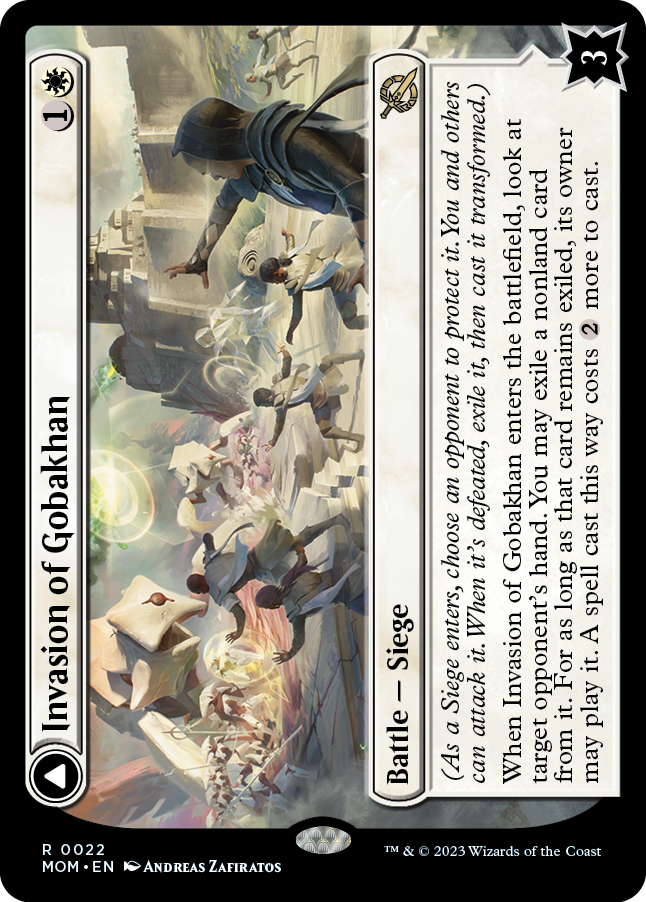
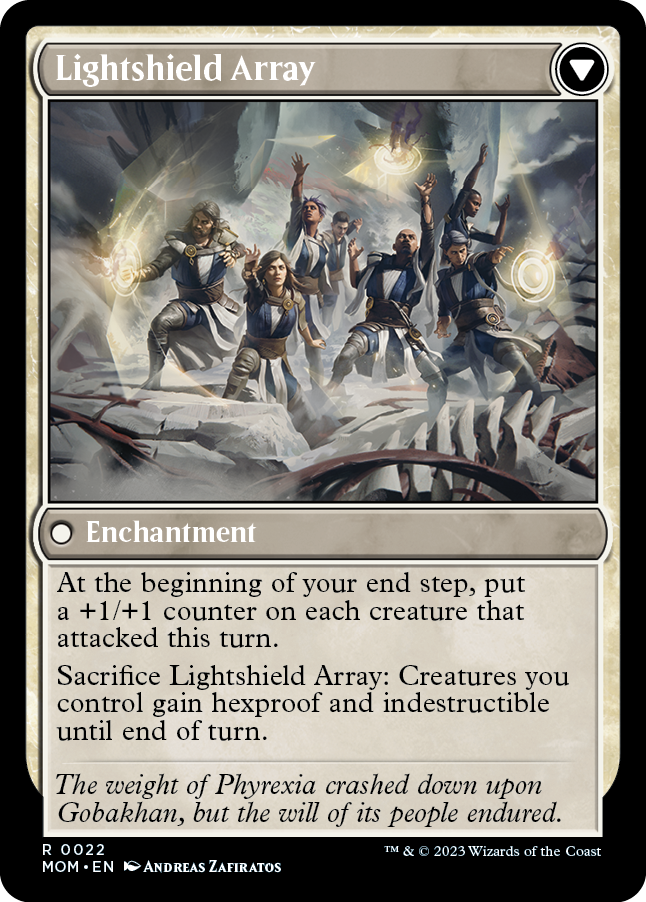
Invasion of Gobakhan
Battle — Siege
(As a Siege enters, choose an opponent to protect it. You and others can attack it. When it's defeated, exile it, then cast it transformed.)
When Invasion of Gobakhan enters the battlefield, look at target opponent's hand. You may exile a nonland card from it. For as long as that card remains exiled, its owner may play it. A spell cast this way costs {2} more to cast.
Sets that primarily take place there: None
Planeswalker natives (with planeswalker cards): Teyo
Gobakhan is a desert plane with two suns. The plane is surrounded by two giant sandstorms, known as the Eastern Cloud and Western Cloud. Each sandstorm has diamond micrograins in it, making them exceedingly deadly. The people of Gobakhan are protected by the monks of the Order of the Shield Mage who use special shield magic to protect them. We first heard about this plane when Teyo Verada showed up to fight in the War of the Spark. He was formerly in the Order.
We knew that both faces had to be referencing the Order of the Shield Mage as they're the main thing known about the plane and would be the force that's protecting Gobakhan from the Phyrexian invasion. That flavor pushed this card to white and meant both the ETB effect and the prize for defeating the battle needed a protective element to it. For the ETB effect, we borrowed an effect that premiered on
We wanted the back face to be protective in flavor, but we didn't want it stalling out games, so we needed to give it an aggressive element. We liked the idea of +1/+1 counters as a symbol of protection, but one that encouraged attacking. We then gave it the sacrifice ability to allow you to one-time save your creatures but at the cost of the permanent.
Invasion of Theros

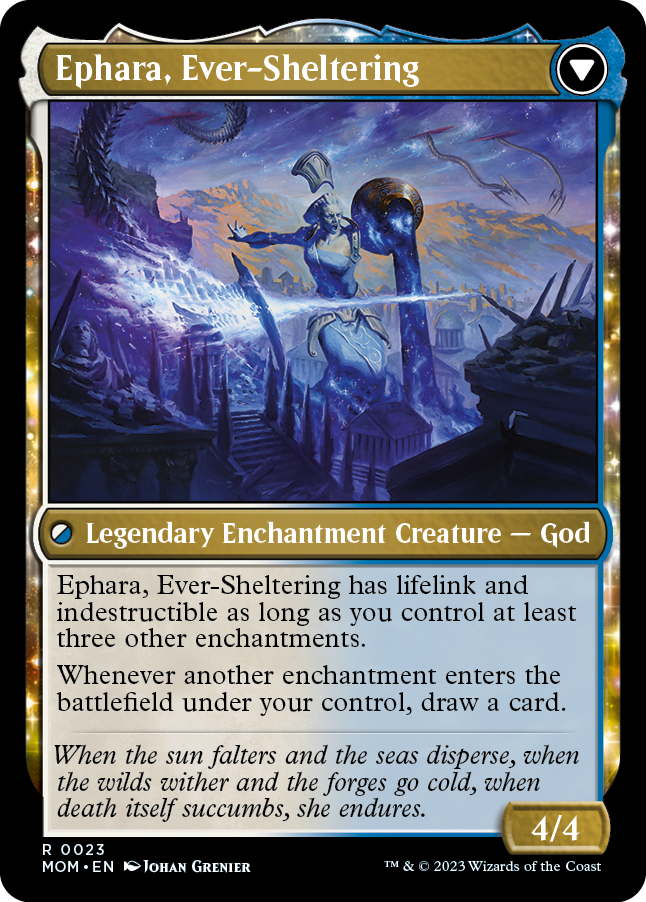
Invasion of Theros
Battle — Siege
(As a Siege enters, choose an opponent to protect it. You and others can attack it. When it's defeated, exile it, then cast it transformed.)
When Invasion of Theros enters the battlefield, search your library for an Aura, God, or Demigod card, reveal it, put it into your hand, then shuffle.
Sets that primarily take place there: Theros, Born of the Gods, Journey into Nyx, Theros Beyond Death
Planeswalker natives (with planeswalker cards): Calix, Gideon, Niko, and Xenagos
Theros is a plane inspired by Greek mythology. As such, it has a pantheon of gods with the God subtype—five monocolor and ten two-color cards. The plane has a strong mechanical tie to enchantments, which is flavored as the influence of the gods. In addition to gods, there are a lot of heroes and monsters.
Wherever we could, we tried to use the back face to reference any important story points about the battle on that plane. This card is an example of that. In the story, most of the gods fall to the Phyrexians. As their followers are compleated, it starts affecting the gods. Ephara is one of the last remaining gods protecting Theros after the other gods have fallen. Because Ephara's color identity is white-blue, we wanted this card to be either white or blue. White has much more affinity for enchantments, so it was the better choice for color.
We knew we wanted the Theros battle to reference enchantments, as it's such a core part of the plane, so we made Ephara into an "enchantress" (a term for a creature that draws you cards when you play enchantments). We even tied her indestructability, something all Therosian gods have, to enchantments. We then made the front of the card a tutor (a card that fetches a card from your library and puts it into your hand) that could go get one of three subtypes, not only all things found on Theros, but also all enchantments on Theros. This will help you in your quest to win the battle and make Ephara indestructible. For backwards compatibility, we chose things that can mostly be found in other sets.
Invasion of Arcavios
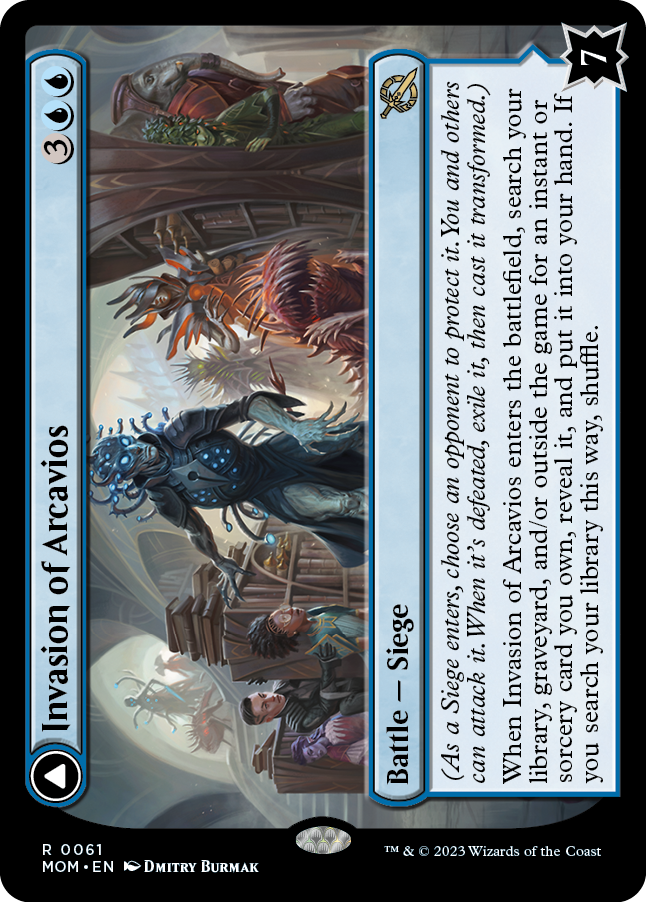

Invasion of Arcavios
Battle — Siege
(As a Siege enters, choose an opponent to protect it. You and others can attack it. When it's defeated, exile it, then cast it transformed.)
When Invasion of Arcavios enters the battlefield, search your library, graveyard, and/or outside the game for an instant or sorcery card you own, reveal it, and put it into your hand. If you search your library this way, shuffle.
Sets that primarily take place there: Strixhaven
Planeswalker natives (with planeswalker cards): None, but Quintorius did spark in the March of the Machines story (more on that in a second); there are numerous other Planeswalkers that live on Arcavios, but none that are native to it.
Arcavios is the homeworld of Strixhaven University. It's mostly defined mechanically by the one set that took place there, which meant going back to themes like instants and sorceries and pushing blue, as the flavor of education is core to the identity of Arcavios.
We wanted each plane to fend off the Phyrexians in a means that spoke to what that plane was about. Arcavios, and Strixhaven University in particular, is all about knowledge of magic, so it seemed only right for a giant spell to be the thing that saves Arcavios. To add a little extra flavor, the five students (Killian, Rootha, Dina, Quintorius, and Zimone) who we followed in the stories about Strixhaven are the five students who cast the spell. It is this incident that causes Quintorius to spark and become a Planeswalker.
We wanted both the ETB and back face to be tied to instants and sorceries. The front fetches one for you, from various zones, and the back is an enchantment that copies any instant or sorcery you cast.
Invasion of Kamigawa
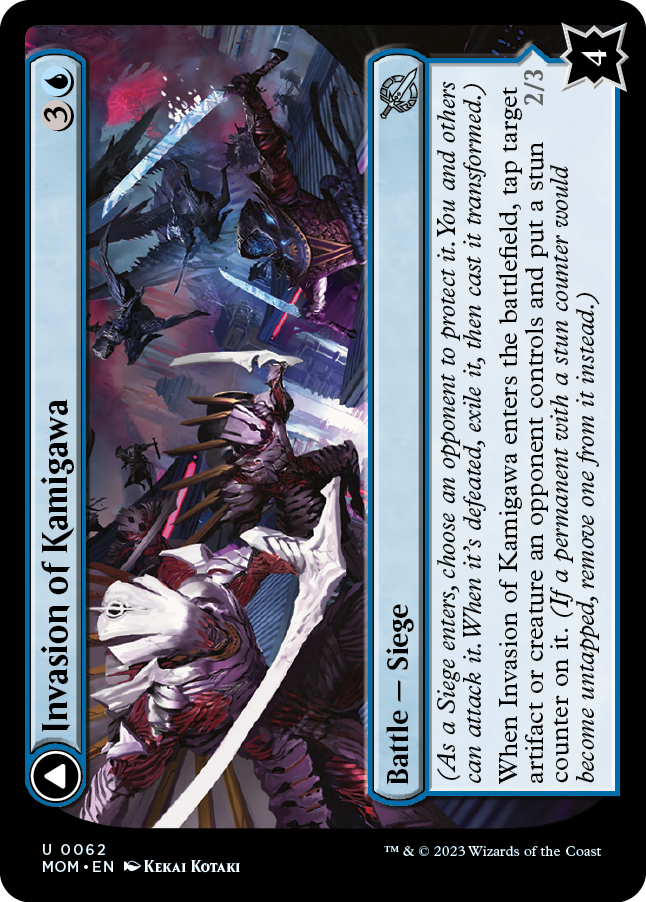
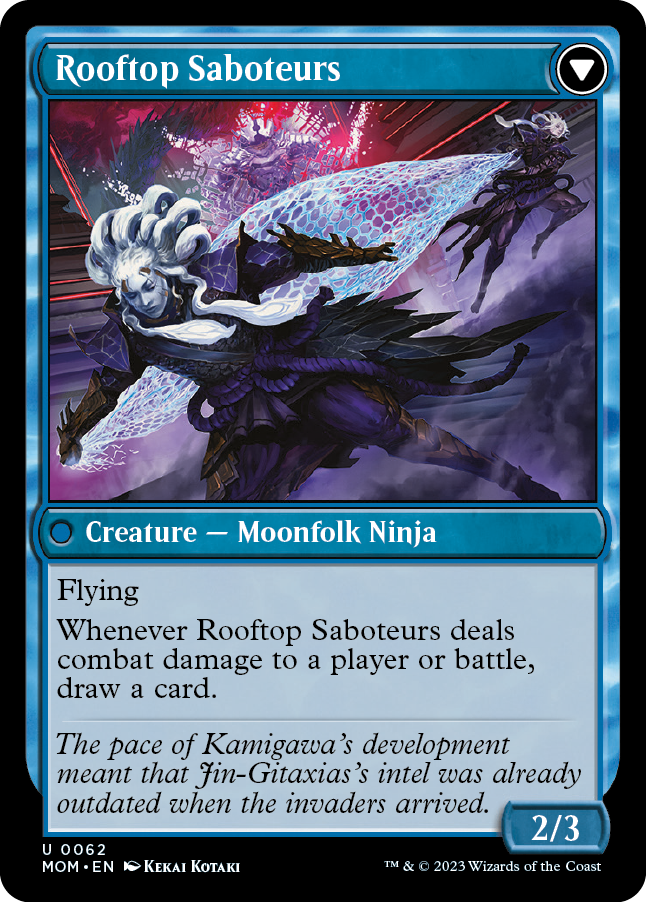
Invasion of Kamigawa
Battle — Siege
(As a Siege enters, choose an opponent to protect it. You and others can attack it. When it's defeated, exile it, then cast it transformed.)
When Invasion of Kamigawa enters the battlefield, tap target artifact or creature an opponent controls and put a stun counter on it. (If a permanent with a stun counter would become untapped, remove one from it instead.)
Sets that primarily take place there: Champions of Kamigawa, Betrayers of Kamigawa, Saviors of Kamigawa, and Kamigawa: Neon Dynasty
Planeswalker natives (with planeswalker cards): Kaito, Tamiyo, and the Wanderer
Kamigawa is a plane initially inspired by Japanese mythology. When we returned to the plane (many years after the first visit—both for the plane and in the game), we also added elements influenced by Japanese pop culture. The plane's core conflict is based around a fight between modernity and tradition.
For this card, we were influenced by making the card capture the feel of a Ninja, one of the creature types that is found primarily on Kamigawa. The front face makes use of a new evergreen ability we call stun, which puts a counter on a permanent (this card just does it to an artifact or creature) to keep it from untapping for a turn. This is especially useful on a battle because it can allow you to remove a blocker to let you attack the battle right away.
The back face is a Ninja, a Moonfolk Ninja no less (Moonfolk are unique to Kamigawa) that has the curiosity ability (you draw a card when you deal combat damage to a player) but adapted so that you also draw a card if you damage a battle. Ninjas are mostly in blue and black, so the card had to be one or both of those two colors. The abilities are all blue, so we made the card blue.
Invasion of Segovia
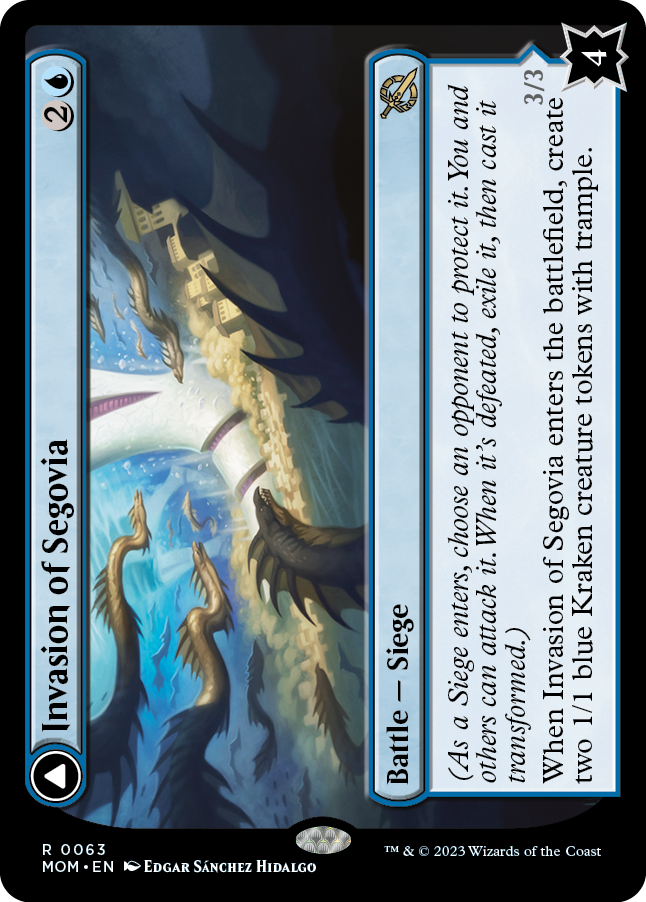
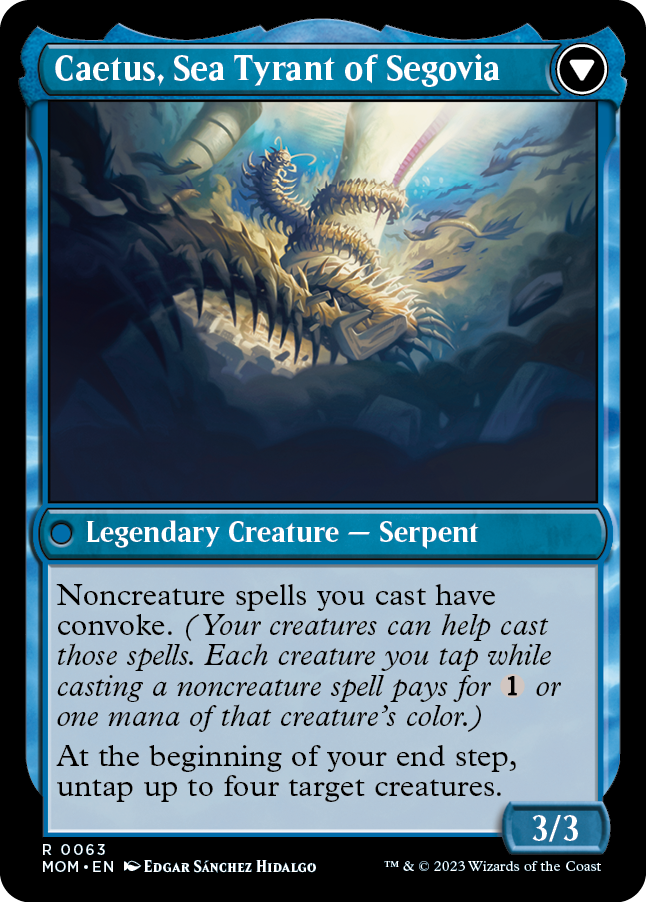
Invasion of Segovia
Battle — Siege
(As a Siege enters, choose an opponent to protect it. You and others can attack it. When it's defeated, exile it, then cast it transformed.)
When Invasion of Segovia enters the battlefield, create two 1/1 blue Kraken creature tokens with trample.
Sets that primarily take place there: None
Planeswalker natives (with planeswalker cards): None
The entire existence of the plane of Segovia is basically a big inside joke. In Legends, the following card appeared:
The art of
It used to be something players enjoyed making fun of, so the Creative team at Wizards at the time came up with a flavor explanation. It was from the plane of Segovia where everything is tiny.
For the card, we wanted to lean into the joke, so we made the back face a legendary Serpent. A 3/3, of course, which had to be blue. The ETB makes a similar joke by making two 1/1 Krakens. Krakens are famously a larger creature. We then gave the Serpent an ability that would work well with the ETB effect. One, it grants all your noncreature spells convoke, so you can use your creatures to cast them. Two, it untaps four creatures to allow you to use them a second time to help cast a spell on an opponent's turn.
The final thing I want to point out is the art. The thing the serpents are fighting with on both faces of the card is the foot of a Phyrexian which is obviously significantly larger.
Invasion of Vryn
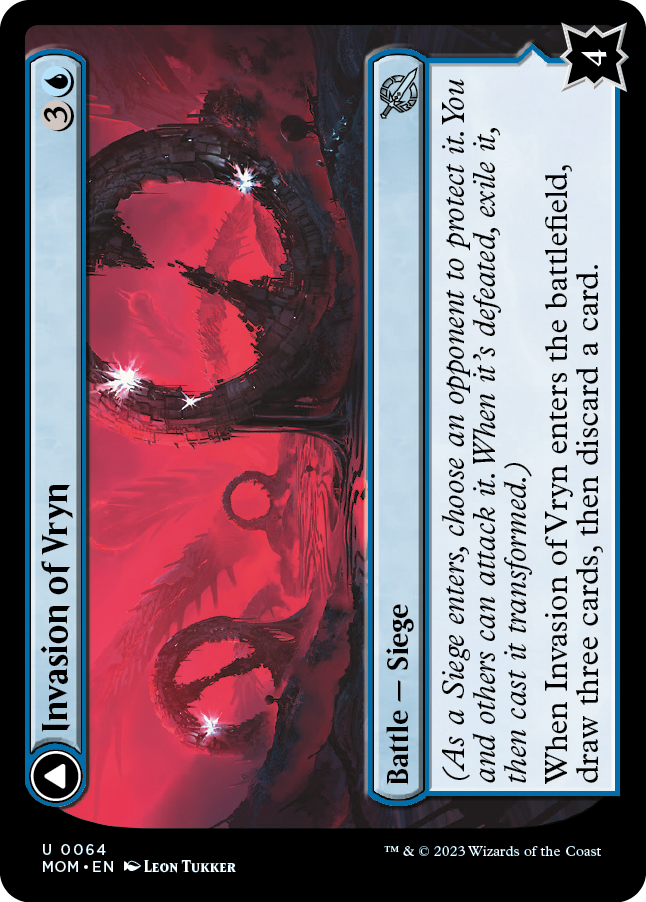
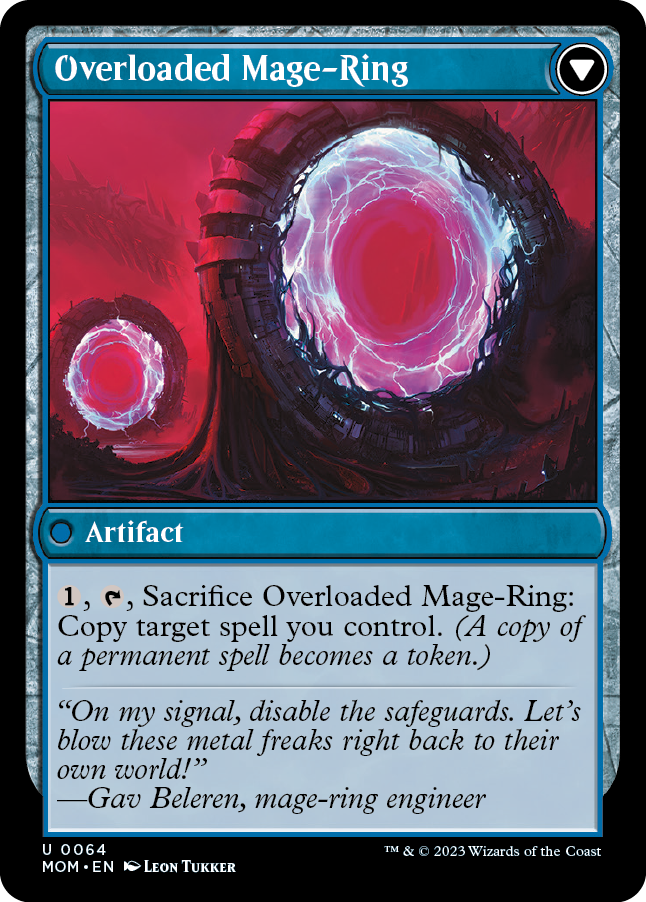
Invasion of Vryn
Battle — Siege
(As a Siege enters, choose an opponent to protect it. You and others can attack it. When it's defeated, exile it, then cast it transformed.)
When Invasion of Vryn enters the battlefield, draw three cards, then discard a card.
Sets that primarily take place there: None
Planeswalker natives (with planeswalker cards): Jace
Vryn is Jace's homeworld. We've only seen it briefly in Magic Origins and on a single plane from Planechase (2012 Edition).
We don't know a lot about it, partially because Jace was missing his memory for much of the story. We do know that the mage-rings play an important role and that they're used to gather mana. Because the most defining part of Vryn is that it's Jace's homeworld, we knew we wanted the battle to be blue.
We were aware of two things that we wanted the card to do mechanically. We wanted the back to be a mage-ring artifact, and we wanted it to be an uncommon blue card. We decided we liked the back being a copy effect, although one you could only use once because it's uncommon. We made the ETB effect a combination of card draw and card filtering, thus increasing your chances of drawing the cards you need to win the battle, and maybe even the card you'll later copy with the Overloaded Mage-Ring.
The back face, along with the flavor text, explains how the denizens of Vryn defeat the Phyrexians, by overloading the mage-rings.
Invasion of Eldraine
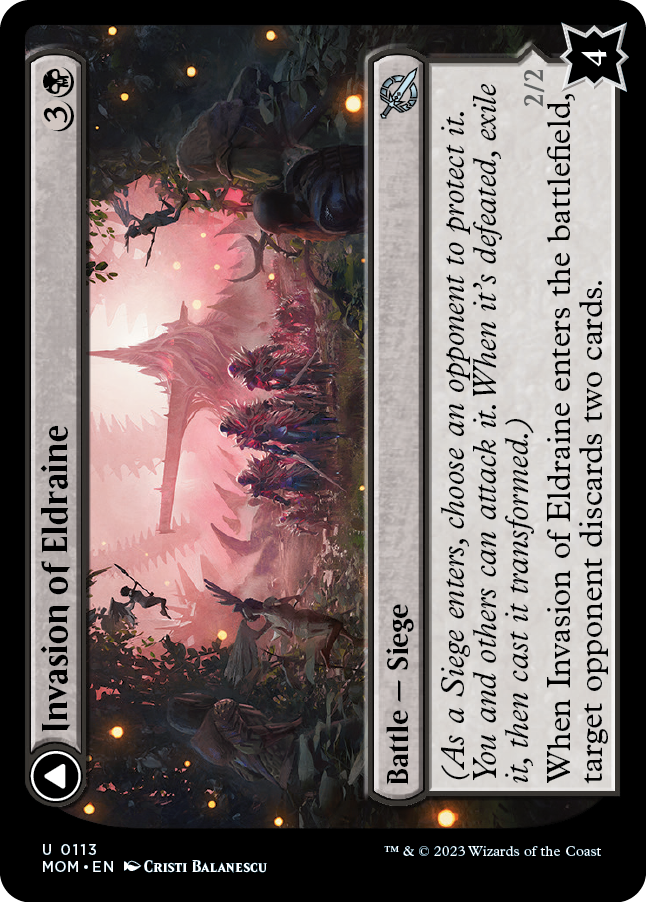

Invasion of Eldraine
Battle — Siege
(As a Siege enters, choose an opponent to protect it. You and others can attack it. When it's defeated, exile it, then cast it transformed.)
When Invasion of Eldraine enters the battlefield, target opponent discards two cards.
Sets that primarily take place there: Throne of Eldraine and Wilds of Eldraine (coming later this year)
Planeswalker natives (with planeswalker cards): Rowan and Will
Eldraine was inspired by Camelot and fairy tales. It uses both source materials to make a lot of top-down cards that add a Magic twist to the classic stories. The set has some dark overtones, so it felt like it would be a good fit for one of the uncommon black battles.
I went back and looked at the origins of this card and discovered that it had been different planes. It started as a "demonic" tutor on Theros (you can see above that we restricted the tutor and then moved it into white to allow us to get Ephara on the back face). It was then turned into a discard card. First it was Rabiah (the plane Arabian Nights takes place on). Then it was Equilor (a plane that shows up on two plane cards in Planechase sets). Finally, it became Eldraine.
I believe this came about because they wanted a mischievous creature on the back that punished the opponent for not having enough cards in their hand, and flavor-wise, that felt a lot like a faerie (it was an imp when it was on Equilor). Faeries were an iconic part of Eldraine and showed up in white, blue, and black, so it was a perfect fit.
Invasion of Fiora
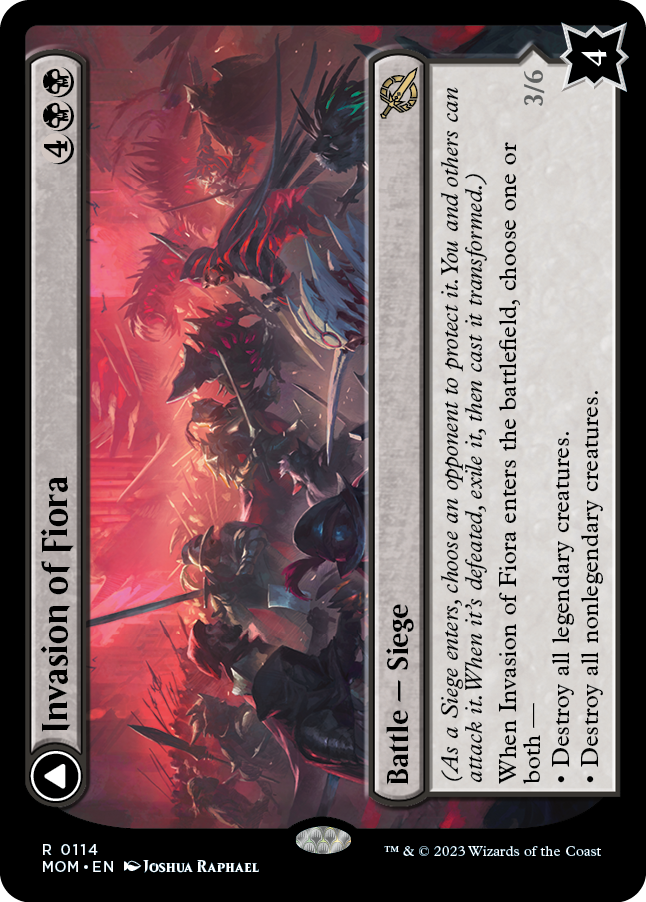

Invasion of Fiora
Battle — Siege
(As a Siege enters, choose an opponent to protect it. You and others can attack it. When it's defeated, exile it, then cast it transformed.)
When Invasion of Fiora enters the battlefield, choose one or both —
• Destroy all legendary creatures.
• Destroy all nonlegendary creatures.
Sets that primarily take place there: Conspiracy and Conspiracy: Take the Crown
Planeswalker natives (with planeswalker cards): Dack and Daretti
Fiora is a plane inspired by Renaissance Italy. It first showed up in the IDW comic The Spell Thief. It was then used as the setting for both Conspiracy sets which highlighted the political nature of the plane. The most popular character from Fiora is Marchesa, who aggressively politicked (including murder) her way into becoming the queen of Fiora. The nature of Fiora made mono-black the perfect color choice for the battle.
Marchesa was such an iconic character that we decided we wanted her to be on the back face of the battle. She's a dangerous woman, so we gave her menace and deathtouch (a previous incarnation of her had deathtouch). Her attack ability allows her to kill things and/or weaken them, which includes winning battles. Her last ability implies her political machinations to help you get resources, although it comes at a cost.
Because this was a rare with a high mana value, we were able to have a larger ETB effect. Many creatures die in Fiora, so making it a mass creature-killing effect felt right.
Invasion of Innistrad
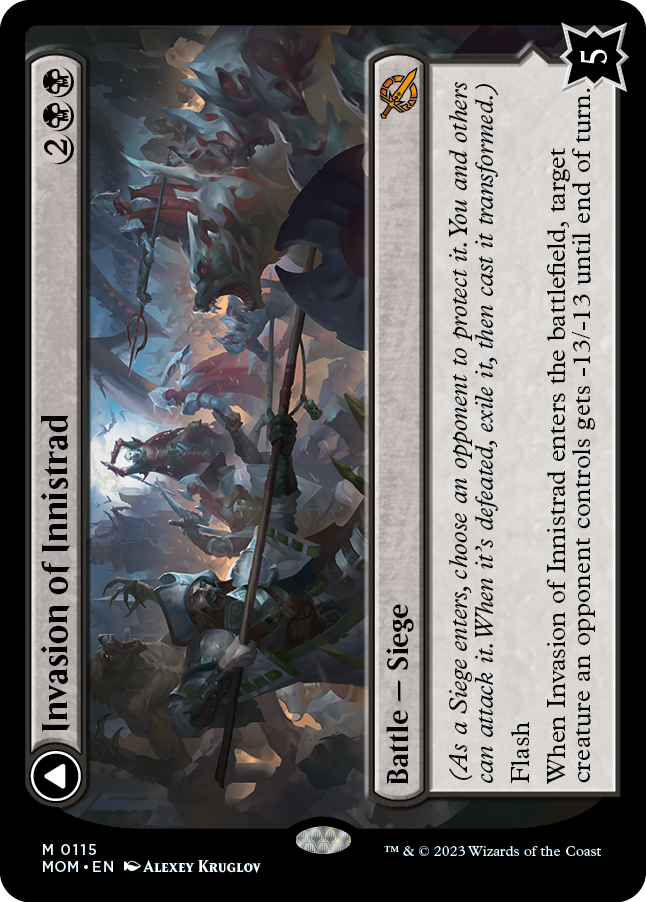

Invasion of Innistrad
Battle — Siege
(As a Siege enters, choose an opponent to protect it. You and others can attack it. When it's defeated, exile it, then cast it transformed.)
Flash
When Invasion of Innistrad enters the battlefield, target creature an opponent controls gets -13/-13 until end of turn.
Sets that primarily take place there: Innistrad, Dark Ascension, Avacyn Restored, Shadows over Innistrad, Eldritch Moon, Innistrad: Midnight Hunt, and Innistrad: Crimson Vow
Planeswalker natives (with planeswalker cards): Arlinn, Sorin, and Tibalt
Innistrad is a plane inspired by the horror genre, especially the subset of gothic horror. As such, it leans heavily on a quartet of monsters—vampires, werewolves, zombies, and spirits. It is also strongly associated with graveyard mechanics. At seven visits, it is the third most visited plane. Innistrad always leans toward the color black, so it was the obvious choice for the color of the battle.
The key to the denizens of Innistrad defeating the Phyrexians rested in the inability of the Phyrexians to compleat Innistrad zombies. Something about the nature of the magic used to animate them makes them immune to phyresis (the process that turns things into Phyrexians).
This meant we wanted the back face to be a means to get a lot of Zombies. We ended up making an enchantment that enters and gives you two 2/2 black Zombie creature tokens and then lets you spend mana to turn dead creature cards from any graveyard into Zombies. We then made the ETB a creature kill spell so you can kill something that you'll later turn into a Zombie. We made it -13/-13 for style, as the number thirteen is a common theme in all the Innistrad sets.
Uphill Battle
That's all the time I have for today. As always, I'm eager to hear your thoughts on today's column, any of the battles or planes I talked about, or just March of the Machine as a whole. You can email me or contact me through my social media accounts (Twitter, Tumblr, Instagram, and TikTok).
Next week, I'll do part two (and then part three the week after that).
Until then, may you have many memorable battles of your own.

